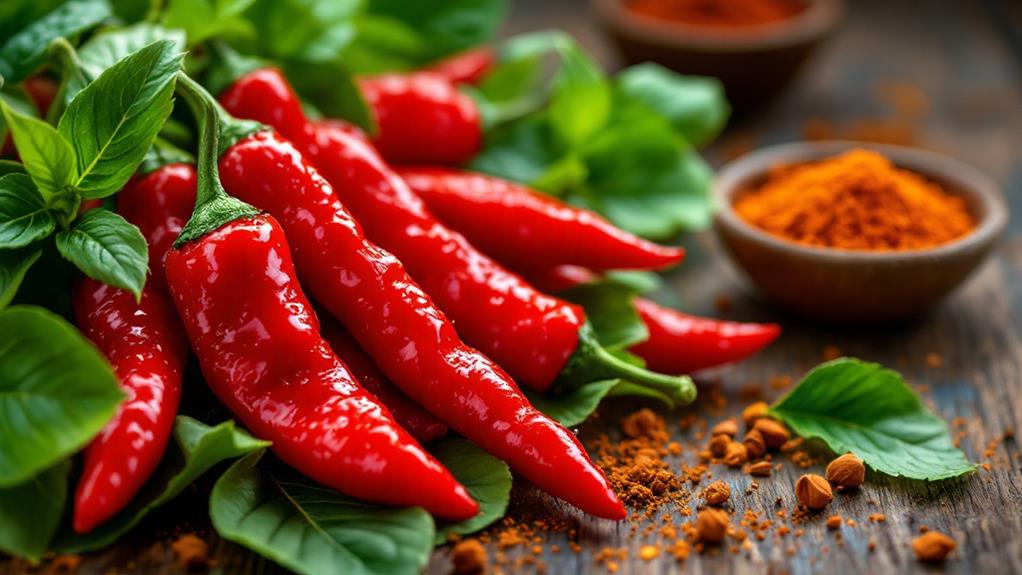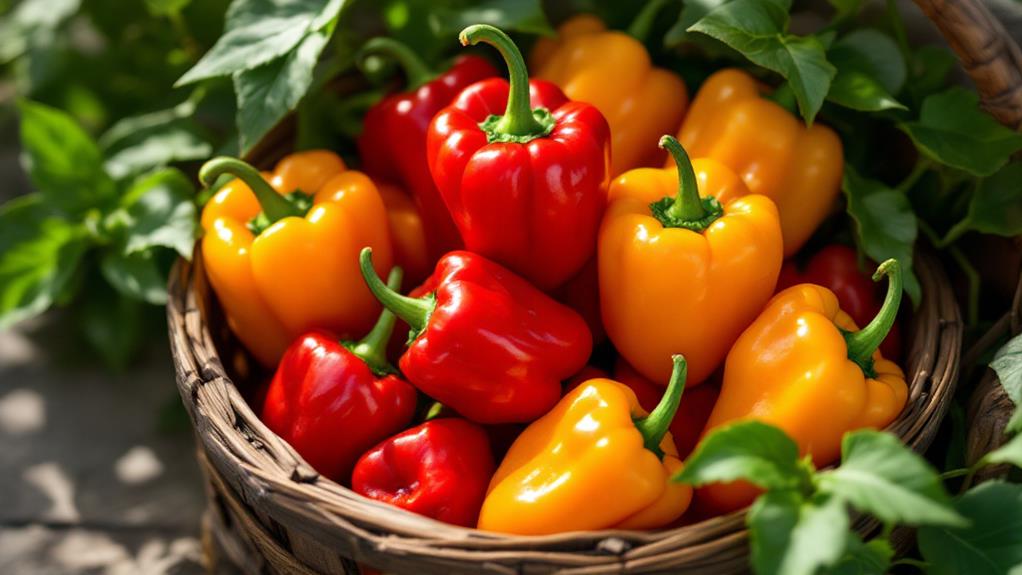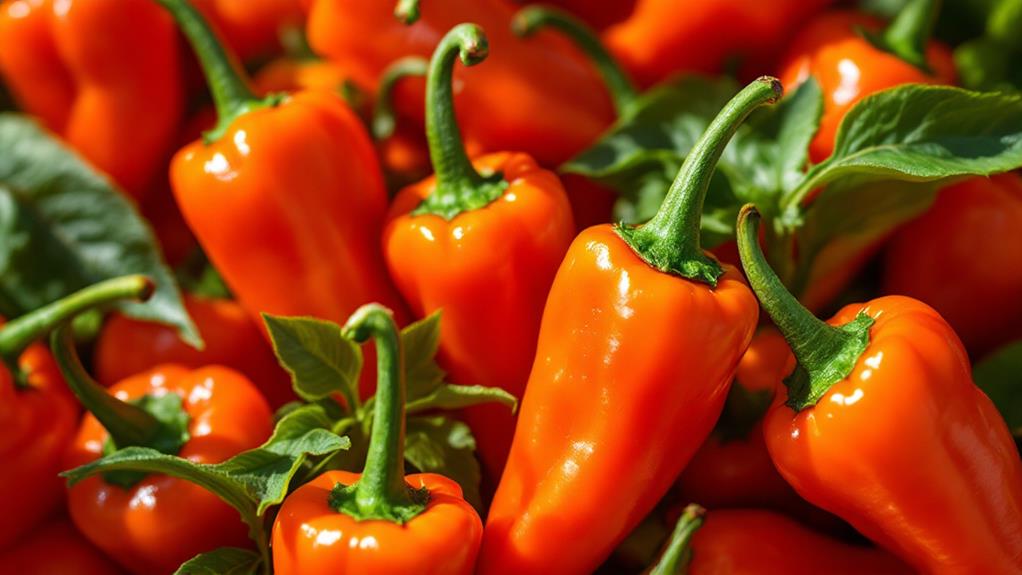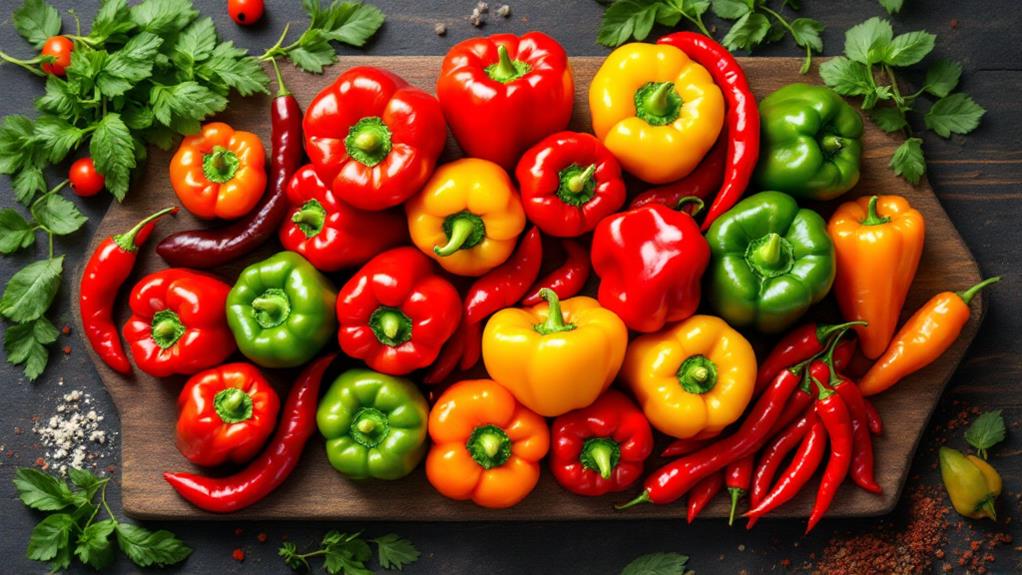The Bird’S Eye Chili Pepper: a Small Pepper With Big Heat
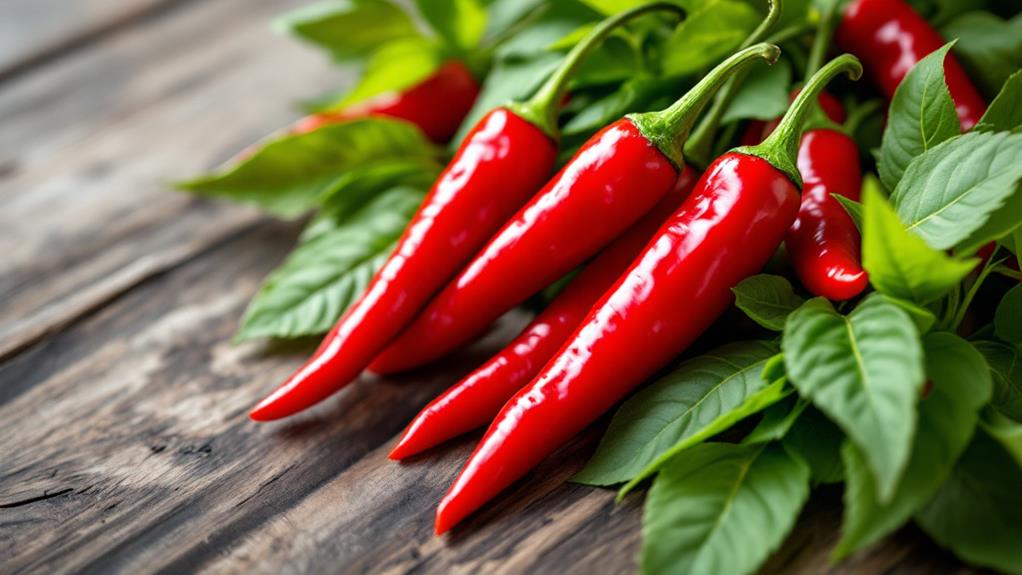
You'll find that the Bird's Eye Chili Pepper, native to Southeast Asia, is a small powerhouse with intense heat reaching 50,000 to 100,000 Scoville Heat Units. It's far hotter than a jalapeño. This lively pepper brings a fiery kick to Southeast Asian dishes like Thai curries and Vietnamese soups. Rich in vitamins A and C, it enhances your immunity while offering anti-inflammatory benefits. With versatile uses beyond cooking, it even serves as a natural insect repellent. If you're handling it, be cautious—it can irritate skin and eyes. Uncover more about its rich history and diverse applications next.
Origin and Characteristics
Originating from the lively regions of Southeast Asia, the Bird's Eye Chili pepper packs a punch in both history and heat. Known for its fiery kick, this small but mighty pepper is native to countries like Cambodia, Vietnam, Thailand, and The Philippines. As a cultivar of the Capsicum annuum species, the Bird's Eye chili stands out with its distinct origin and impressive characteristics.
You'll notice these peppers are small and tapering, usually around 2-3 cm in length. Despite their size, they wield a formidable heat level, far surpassing that of a jalapeño. Their Scoville Heat Unit (SHU) rating ranges between 50,000 to 100,000, making them a staple in spicy dishes across their native lands. The Bird's Eye chili can mature into a variety of colors, including red, yellow, purple, and even black, each bringing unique flavors and heat profiles to your plate.
Interestingly, these peppers don't just add zest to your meals. Historically, they've been used in traditional remedies to tackle ailments like arthritis and toothache. Thriving in warm climates, the perennial plant often produces two to three fruits per node, appreciating well-drained soil and plenty of sunlight.
Heat Level and Scoville Rating
As you investigate the domain of Bird's Eye Chili peppers, their heat level becomes impossible to ignore. These fiery little hot peppers pack a punch with a Scoville Heat Unit (SHU) rating ranging between 50,000 to 100,000. This makes them considerably spicier than your average jalapeño, which hovers around 5,000 SHU. In fact, Bird's Eye Chili Peppers can be up to 20 times hotter than jalapeños, putting them in the same heat category as the notorious habaneros.
The intense heat level of Bird's Eye Chilies is primarily due to capsaicin, the compound responsible for both their pungency and medicinal properties. Capsaicin is what sets these chilies apart, making them a staple in many spicy dishes worldwide. Regardless of whether they're green or ripened to a vivid red, their fiery essence remains consistent, ensuring that every bite delivers a robust kick.
Here's why Bird's Eye Chili Peppers stand out:
- Scoville Rating: 50,000 to 100,000 SHU, among the spiciest.
- Capsaicin Content: High, responsible for their intense heat.
- Culinary Versatility: Maintains heat at both green and red stages.
Dive into the territory of Bird's Eye Chilies, and you'll experience heat like never before.
Culinary Uses
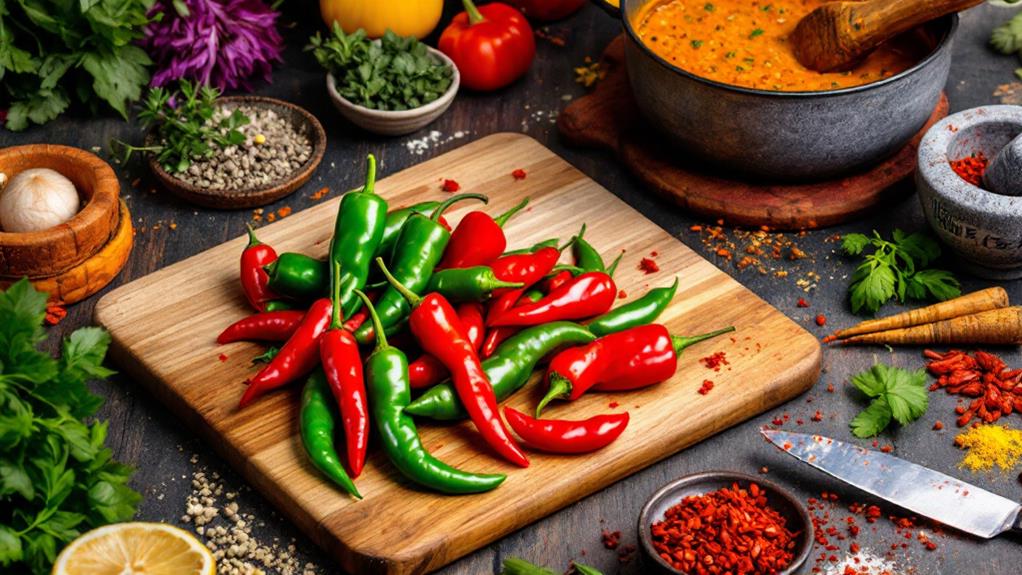
Bird's Eye chili peppers are a powerhouse ingredient in Southeast Asian cuisine, bringing intense heat and a fruity flavor to dishes like Thai curries, Vietnamese soups, and Indonesian sambals. This pepper variety is versatile in culinary applications. You can use them fresh or dried, making them a reliable choice for sauces, marinades, and dips. Ground into chili powder, Bird's Eye chili can boost the heat in any recipe you're preparing.
In Thai cuisine, Bird's Eye chili is often paired with fish sauce and lime, adding a zesty kick that improves the dish's complete flavor profile. This combination is perfect for creating a balance of heat and tangy freshness. When handling these peppers, take precautions as their capsaicin can irritate the skin and eyes. If you want to reduce the heat, consider removing the seeds before using them in your cooking.
Besides adding spice to your meals, Bird's Eye chili can serve as a natural insect repellent or pesticide, showcasing its multifaceted use beyond the kitchen. Regardless of crafting a fiery dish or exploring its other benefits, Bird's Eye chili peppers certainly pack a punch.
Health and Benefits
When you investigate the health benefits of Bird's Eye chili peppers, you'll find they're packed with essential vitamins A and C, which are fundamental for enhancing your immune health and general well-being. These little peppers are not just about heat; they're a powerhouse of nutrition that can provide diverse health advantages. The capsaicin in Bird's Eye chili is renowned for its anti-inflammatory properties. This natural remedy may ease pain and reduce inflammation, offering relief from conditions like arthritis and rheumatism.
Regularly consuming Bird's Eye chili peppers might also enhance your metabolism. This increase can aid in weight management and improve digestion, making it easier for your body to process food efficiently. Plus, the antioxidants in these peppers can combat oxidative stress, potentially lowering your risk of chronic diseases.
Here's a quick rundown of the health perks you can enjoy:
- Immune support: Thanks to vitamins A and C.
- Pain relief and reduced inflammation: Courtesy of capsaicin.
- Enhanced metabolism and digestion: Aids in weight management.
In traditional medicine, Bird's Eye chili has been used for numerous ailments, underscoring its cultural and medicinal importance. They're not just a fiery supplement to your meal but a beneficial one too!
Growing and Cultivation
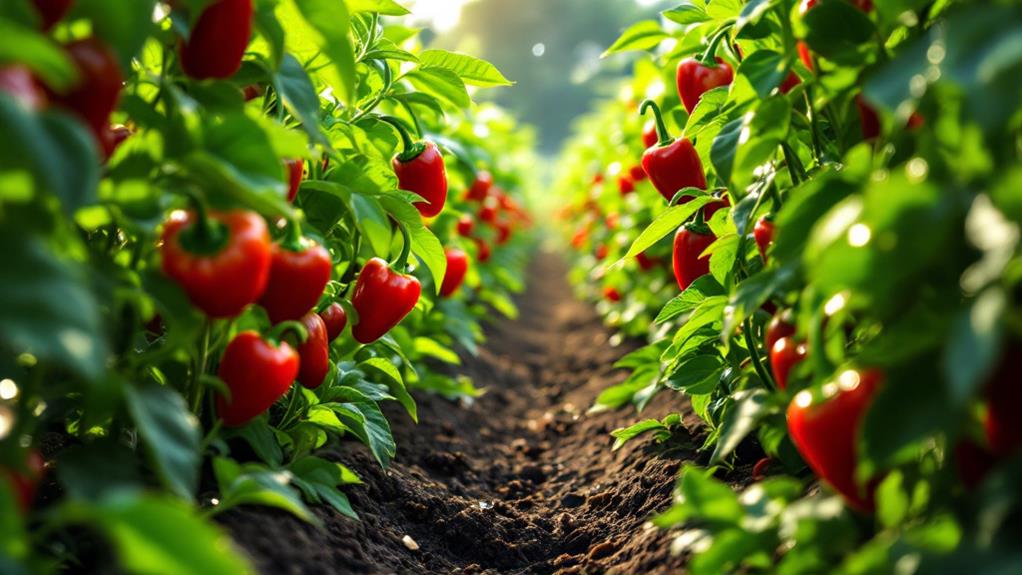
Cultivating Bird's Eye chili peppers can be a rewarding endeavor, especially if you live in a warm, humid climate. These feisty peppers are easy to grow and thrive in well-drained soil with a pH of 6.0-7.0. For ideal growth conditions, make certain your garden or pots are positioned where they receive plenty of sunshine. Regardless of you're working with a sprawling garden or a compact urban space, Birds Eye chili plants adapt well, growing happily in pots or garden beds.
Pay close attention to watering practices. While regular watering is essential, avoid waterlogging the soil. The key is to maintain consistent moisture levels without saturating the roots. You'll want to check the soil regularly to verify it's damp but not soggy. As the plants mature, typically over 75-90 days, you'll notice the small, tapering fruits that can be picked green or left to ripen to a fiery red.
Consider companion planting to enhance your Birds Eye chili's growth and health. Herbs like basil and tomatoes make excellent companions, offering natural pest control and improving plant vitality. By following these guidelines, you'll have a bountiful harvest of spicy peppers in no time.
Preservation and Storage
As you consider what to do with your harvest, understanding how to preserve and store Bird's Eye chili peppers can guarantee you enjoy their fiery flavor long after picking. Fresh Bird's Eye peppers can be kept in the refrigerator for up to two weeks, retaining their heat and flavor. For a longer-lasting option, freezing is ideal, ensuring their spiciness remains intact for long-term storage. To further extend their shelf life, consider drying them. This not only makes the peppers last longer but also concentrates their flavors, making them a versatile ingredient in your culinary endeavors.
Exploring different preservation methods can add variety to how you use these peppers:
- Pickling: This method doesn't just preserve Bird's Eye peppers, it infuses them with unique, tangy flavors, perfect for adding zest to dishes.
- Ground Chili Powder: Once dried, grinding the chilies into powder form allows for easy storage. Keep this powder in airtight containers to maintain its potency and flavor.
- Drying: A simple method that transforms the peppers into a long-lasting spice, perfect for sprinkling over your favorite meals.
With these methods, you'll have Bird's Eye peppers ready to spice up your culinary creations year-round.
Related Varieties
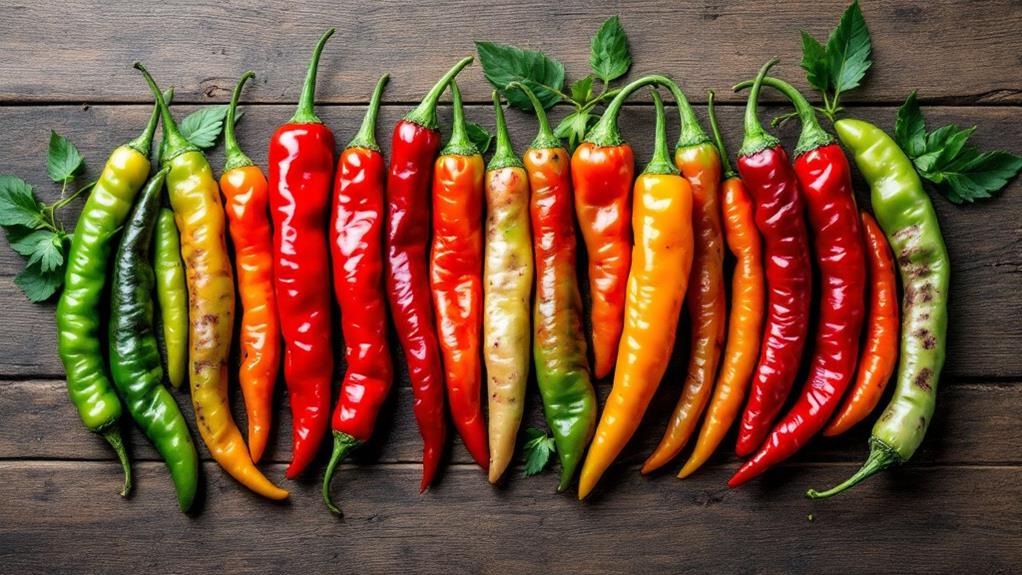
Though Bird's Eye chili peppers are renowned for their fiery heat, exploring related varieties can expand your culinary repertoire. African Birds Eye Chili, also known as Piri Piri, shares a similar heat profile with Bird's Eye chilis. This variety is a staple in African cuisine, often enhancing sauces and marinades with its lively kick. If you're venturing into Filipino cooking, Siling Labuyo is your go-to pepper. Known for its intense heat, it's frequently used in traditional Filipino dishes and sauces, adding that unmistakable spicy punch.
For those who love Mexican cuisine, the Birds Beak Chile, or Chile de árbol, is a must-try. Its tapering shape makes it perfect for salsas and garnishes, providing both heat and flavor. If you're in the mood for something with a citrusy twist, the Tepin x Lemon Drop hybrid will not disappoint. It marries the heat of Tepin with the unique citrus flavor of Lemon Drop.

